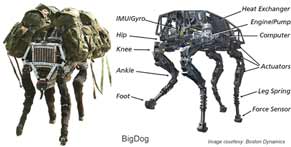Petroleum
Petroleum is a naturally occurring inflammable liquid found beneath the of earth’s surface. Refinement of petroleum or crude oil leads to Petrol (gasoline), Butane, Jet fuel, Kerosene, Fuel oil, Diesel and liquid petroleum gas (LPG). Each of these products has their own distinct area of consumption.
If you are planning to build an outdoor robot, then there are various challenges to think of. The first and foremost is that outdoor robots require greater traversing capability in variable terrain with considerable power supplies. This is when gasoline or diesel power engines help and can supply plenty of power to your robots. Since most motor engines work on gasoline, it is easier to hack a small engine and connect wheels and controls to create a robot. The biggest challenge however is to convert engine’s power into controlled rotation or movement which can be hydraulic powered, or a simple clutch and rotation principle similar to a bike or car. Best option is to convert energy generated from these engines into electrical energy and power the actuators.
One drawback of gasoline powered engines is the size of the robot. Adding these engines makes your robot bulky and hence very impractical for small sized mobile robots. For most small to medium sized robots, a good high powered battery system should work much better as they are cleaner, quieter and the design is a lot simpler. Unless you are ready to build a giant expensive power hungry (smoky and noisy?) military robot, stay away from petroleum based robots.
BigDog is a quadruped robot powered by a single two-stroke engine that drives a hydraulic pump, which in turn drives the hydraulic leg actuators. There are a few hobby RC air-planes available in the market which also uses gasoline powered engines.
Do you have anything to say?
Visit the Forum to discuss, learn and share anything related to robotics and electronics !!









